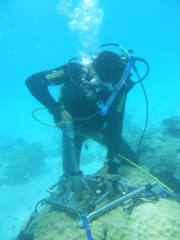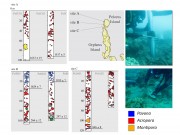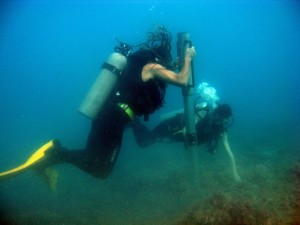NERP TE Project 1.3 - Characterising the cumulative impacts of global, regional and local stressors on the present and past biodiversity of the GBR (UQ)
Project summary
Using pioneering high-precision geological dating and palaeoecological techniques, combined with high-resolution geochemical analysis of coral records, this project will investigate how coral communities have historically responded to acute (e.g. cyclones) and chronic (e.g. water quality) disturbances.
Why this research is needed
Nutrient loading and discharge from agricultural and other land uses are putting increasing pressure on coral communities. More recent threats to the Great Barrier Reef (GBR) include global warming, coral bleaching, ocean acidification and coral disease. This research will provide valuable knowledge that can be used to assess the effects of existing management strategies on the GBR ecosystem.
Research-user focus
The project will deliver outcomes that are useful to a range of stakeholders including local, State and Australian Government bodies, the tourism sector and conservation planners/managers. Specific research-users include the Department of Sustainability, Environment, Water, Population and Communities, the Great Barrier Reef Marine Park Authority and the Queensland Department of Environment and Heritage Protection.
Outcomes
Key outcomes of the project will include:
- Long-term records of coral reef community structure along the length of the GBR to evaluate the ecological effects of run-off from agricultural activities and changes in climate.
- High resolution chronological records of parameters such as sea-level, sea-surface temperature, salinity, pH value, and cyclone frequency on different time scales over the past 1-2 millennia which will enable us to predict future climate scenarios and the responses of coral communities to such changes.
- Long-term trends in coral calcification in response to changes in climate and water quality over the past hundreds to thousands of years.
Reports, Publications and News
For more information see Project 1.3 'Characterising the cumulative impacts of global, regional and local stressors on the present and past biodiversity of the Great Barrier Reef' on the NERP Tropical Ecosystems Hub site.
Images
Datasets

This dataset provides the results of U-Th dating of coral samples obtained from reef matrix percussion cores and death assemblages from Mazie Bay, North Keppel Island, Southern Great Barrier Reef. Data is presented for 117 coral samples ranging in age from 6900 years before present (yr.BP) to modern.

This dataset consists of 43 thermal ionisation mass spectrometry (TIMS) U-Th dates from living Porites spp. of known ages collected from the far northern, central and southern inshore regions of the Great Barrier Reef (GBR) which were used to spatially constrain initial 230Th/232Th (230Th/232Th0) variability.
Such information is essential in providing accurate chronologies used to pinpoint changes in coral community structure and the timing of mortality events in recent time (e.g. since European settlement of northern Australia in the 1850’s).
Methods:

This dataset is the U-series data for Pelorus Island as described in Roff et al (2013) Palaeoecological evidence of a historical collapse of corals at Pelorus Island, inshore Great Barrier Reef, following European settlement. Proceedings of the Royal Society Series B 10.1098/rspb.2012.2100
Methods:

This project will investigate how coral communities along the Great Barrier Reef have historically responded to acute (e.g. cyclones) and chronic (e.g. water quality) disturbances using pioneering high-precision geological dating and palaeoecological techniques, combined with high-resolution geochemical analysis of coral records.
This project will determine high resolution chronological records on different time scales over the past 1-2 millennia of parameters such as:
1. Sea-level based on high-precision dating and elevation survey of well-preserved microatolls;








